How to Make Fake Fury Stringy Again
Allow's face it:
Beards look ameliorate on your face than they practise in your aquarium!
In an aquarium, it merely looks like a fuzzy mess.
I'g talking about black bristles algae. The disguised monster that tin apace take over your tank.
Today, I am going to evidence you lot how to identify it, get rid of information technology, and stop it from coming back!
What is blackness beard algae and how to identify it?
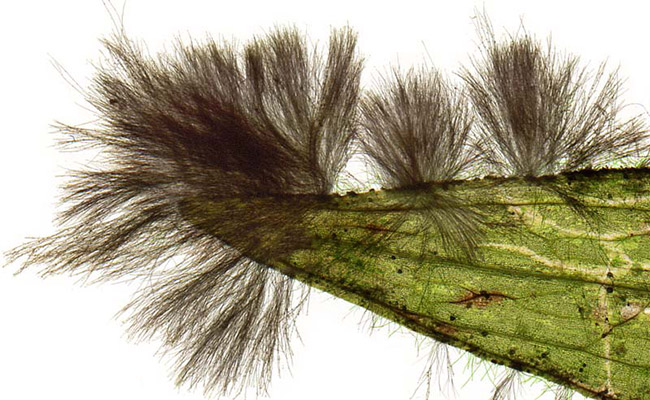
I love it when things are named after what they expect like, and black beard algae is certainly that – a black algae that looks like a scruffy beard. Information technology is also referred to by the name black castor algae or by the initials BBA.
While blackness beard algae is considered to be a saltwater algae, in that location are strains that are mutual to freshwater tanks. In fact, in all my years of fishkeeping, I accept probably seen more freshwater tanks go plagued by this disguised menace than saltwater ones.
It may surprise you to learn that despite its name and wait, black bristles algae is really a fellow member of the red algae family. This shouldn't surprise any of you who accept killed black bristles algae before – it turns a red color as it dies.
Nevertheless, when information technology is healthy, black beard algae's color ranges from a nighttime dark-green, browny gray to a deep black. While its colour may vary, one matter remains constant – its await.</p
Just like a beard, this algae starts out as light stubble – small-scale spots of fuzz that cling to the surface of annihilation in your aquarium.
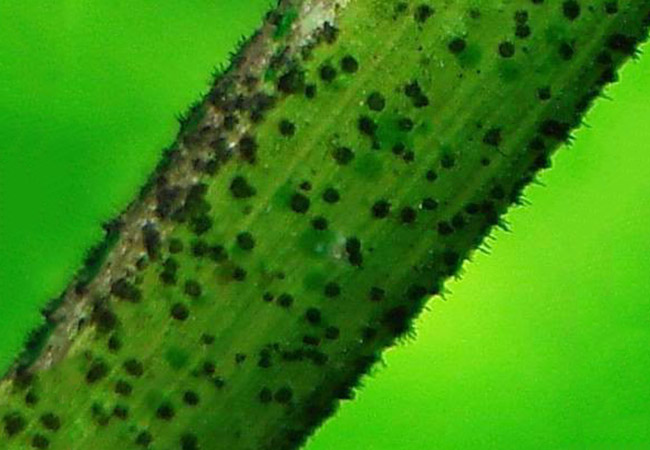
As time passes, the black bristles algae looks more like three-day growth…
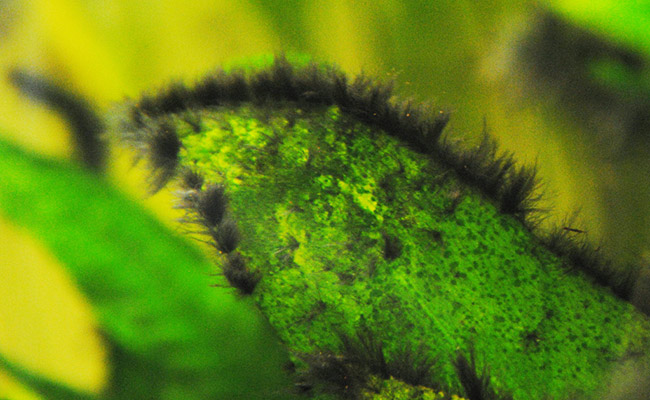
But if left unattended, it soon grows into a glorious, thick and brushy, hair jungle.
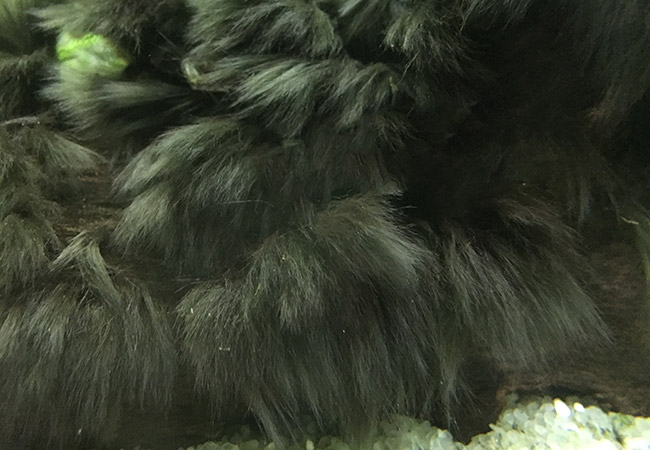
Seriously, it looks like hair straight out of a shampoo commercial!
Like near algae, black beard algae draws its nutrients from the water. This allows it to grow on near any surface in your aquarium including…
Driftwood…
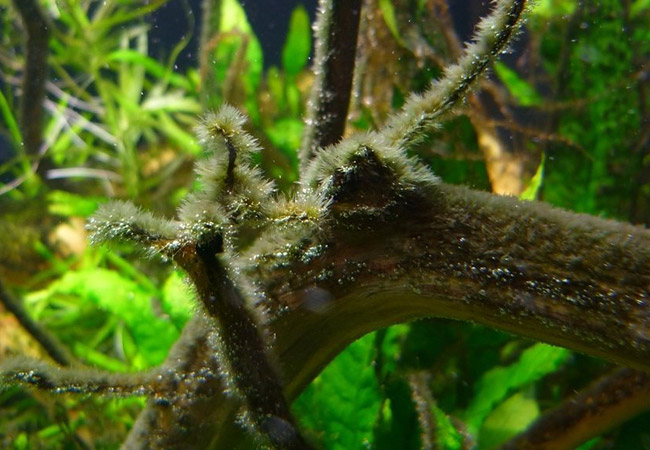
Filter pipes and airline tubing…
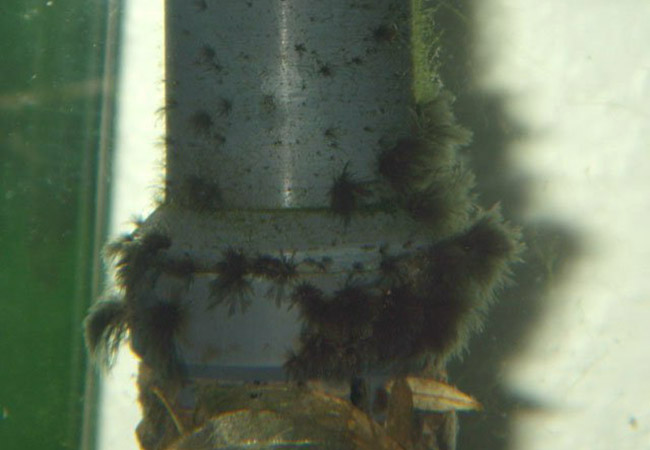
On the surface of your substrate…
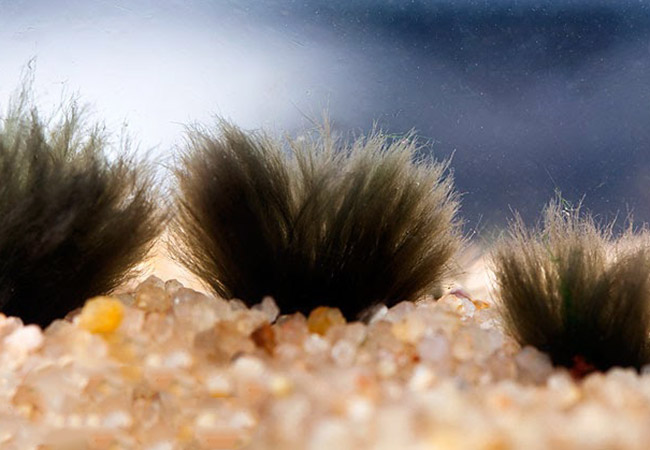
Even on the shell of your snail!
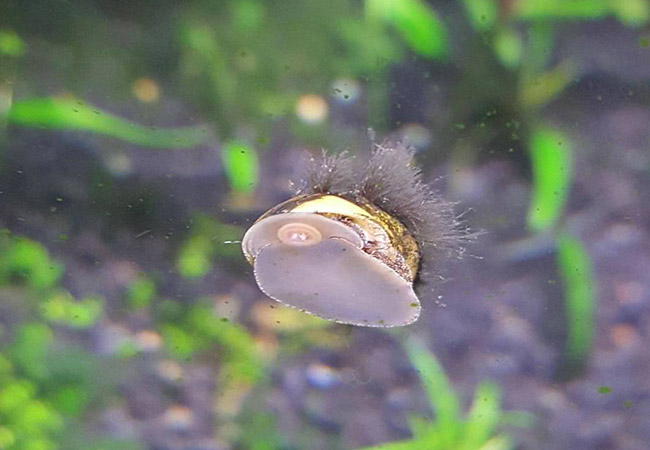
My point is that black beard algae tin grow anywhere. Decorations, rocks, even on the glass of your fish tank!
Black beard algae is easiest to spot when it grows on plants. It typically grows on the edges of the leaves before expanding and covering them completely.
Don't exist confused with…
Blackness beard algae is oft confused with staghorn algae. And, I tin can come across why – fully grown staghorn algae looks much more like a wiry beard than black beard algae does.
And so, how practice you tell the divergence?
Let's compare the two during their early on stages of growth…
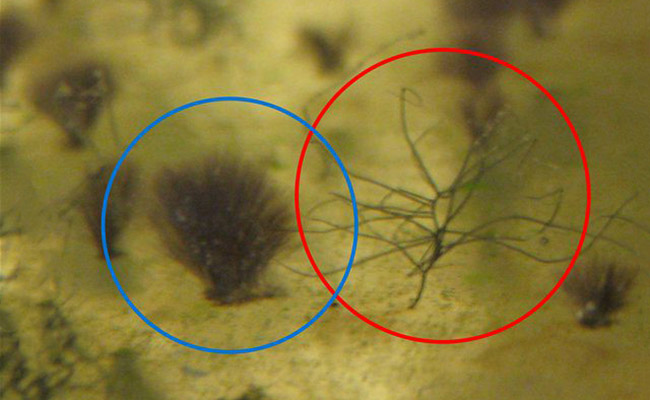
In the blueish circumvolve, yous accept blackness bristles algae, resembling the tightly packed clusters of bristles you lot notice on a makeup brush. Staghorn algae, circled in red, looks more like the antlers of a male deer – hence the name.
When fully grown, the two also wait quite different, just unless you compare them side by side, information technology's easy to run across where the confusion comes from.
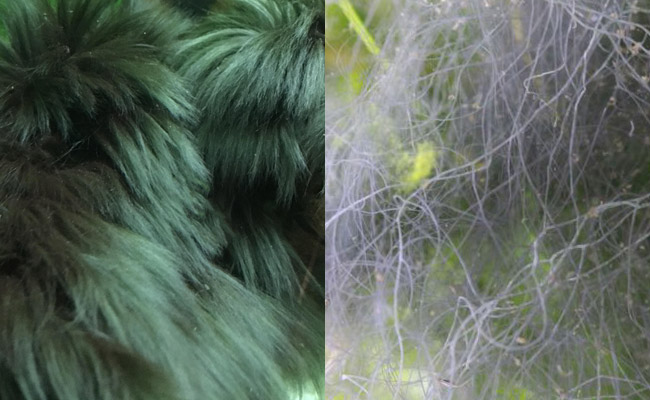
Fully grown black beard algae, on the left, is dense and bushy while staghorn algae, on the right, is sparse and wiry.
For more data and pictures (and how to beat it), bank check out our in-depth staghorn algae guide.
Is black beard algae harmful to fish?
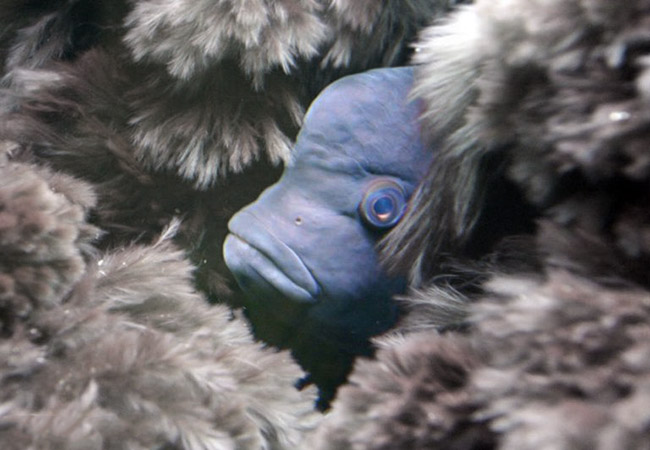
Nope, blackness algae is non unsafe to your fish.
In fact, if yous let your black hair algae grow, many fish happily swim and hide in the long flowing hairs.
Plants on the other mitt…
Is blackness beard algae harmful to plants?
Yes… But not directly.
Let's say that you notice black beard algae start to grow on the edges of one of your plants. No damage washed.
The problem is… As the algae begins to spread, it blocks out more and more light.
And if you know about photosynthesis, y'all are fully aware that light is vital for most aquarium plants to survive. Without it, they die.
And then yep, an uncontrolled spread of black algae tin be particularly dangerous to plants in your aquarium.
You May Besides Read – How to deal with brown algae?
Do you need to remove black bristles algae?
For nigh beginners (and even some experts!), blackness beard algae appears when something isn't quite right in your tank – creating the perfect environs for information technology to grow.
If the crusade isn't fixed, black bristles algae will continue spreading until it takes over your entire tank.
In this example, the reply is obvious:
You want this bearded menace gone, and you want it gone at present!
And, that's merely fine. In fact, I would fence that the majority of hobbyists view black beard algae every bit an ugly menace that needs to be eliminated.
However, there are some instances where black beard algae can be a welcome add-on to your aquarium. Only keep in mind that those who encourage black beard algae are experienced and know what they are doing.
It may surprise you to learn that some fish keepers voluntarily add together blackness beard algae to their aquarium. Yep, what many people consider a pest can likewise become a cute found when properly maintained.
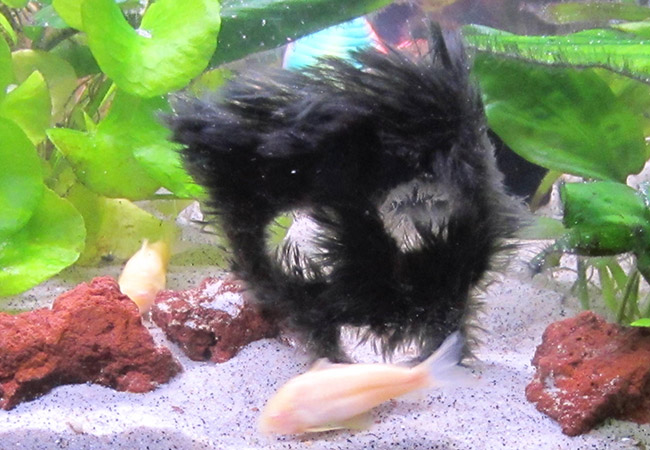
This fish keeper allowed black beard algae to completely encompass a decoration in her aquarium, creating a spooky mask that moves in the h2o.
Some other fish keeper let blackness bristles algae abound all over a sunken log in his aquarium…
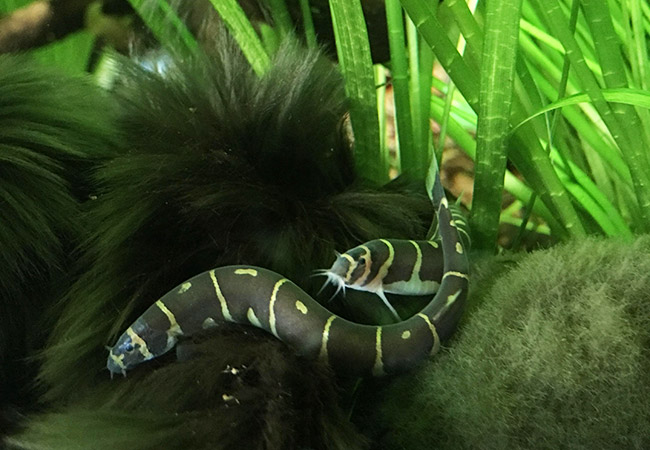
The result is a lovely centerpiece that his fish love to hide in.
As you lot run into, if you know what y'all are doing, black beard algae isn't always bad news!
What is the crusade of blackness beard algae?
1 day information technology isn't in that location, then the next day it is. Information technology feels like black beard algae magically appears on its ain, right?
Well, information technology may surprise you to learn that black beard algae needs a little help from you lot.
Like most plants, algae requires certain weather condition to thrive. If these weather condition are met, black bristles algae spreads across your tank like wildfire. Well, underwater wildfire anyway.
There are two mutual causes of black beard algae…
1. CO2 fluctuations
Information technology is generally accepted that CO2 fluctuations are the number i cause of black beard algae.
If your CO2 levels are too low, your CO2 is fluctuating or you lot take poor h2o circulation, you are creating an environment that is perfect for blackness beard algae to abound.
If you take black beard algae, getting your CO2 levels in order should be your offset priority. Information technology could be your CO2 canister is running depression, there is a blockage or y'all are not injecting the correct amount.
Don't run a CO2-injected tank? Your unstable CO2 levels could be a upshot of h2o changes – a big water change tin significantly fluctuate the CO2 levels in your tank.
If this is the case, and you lot have a planted tank, I highly recommend dosing with Seachem Flourish Excel. It is a uncomplicated additive that provides your plants with a source of carbon, and, as I will hash out later, can be used to effectively kill black bristles algae.
2. Too much calorie-free
Similar many algae, black beard algae loves light. The more lite it has, the faster it spreads. This is a item problem for those of you with planted tanks – that LED grow light isn't merely helping your plants to grow but algae besides.
If you get out your aquarium light on for long periods of time (or never plow information technology off), then you lot are basically encouraging algae to enter your aquarium.
Reducing the amount of time that light shines on your aquarium tin can irksome or even stop black beard algae from appearing birthday.
I recommend using a reliable aquarium timer to automatically plough your LED lights on and off each day. It's easier than manually doing it– something you will certainly forget to do.
Check out our detailed guide on aquarium timers for more data, including which timer is best for your aquarium.
Do you too have problem with blue-greenish algae? Cheque out how to deal with information technology.
How do you remove black beard algae?
Important: To care for black bristles algae, never scrub or pick at it. Your endeavour of removing blackness beard algae by scrubbing it can cause pocket-sized pieces to float and settle on other plants or decorations in your aquarium, causing it to spread faster than earlier.
As mentioned earlier, Black beard algae don't necessarily release whatever harmful toxins. But, a thick layer of Blackness algae tin kill any establish in your tank while also creating an imbalance in your aquarium ecosystem.
Lastly, it isn't a very visually stimulating sight to await at. Many aquarists dislike Blackness algae because of its stubborn nature, which is extremely hard to go rid of.
Your black algae trouble typically won't get away on its own. Not without fixing the cause first – and fifty-fifty then, established algae in your tank will probably crave a little endeavor on your part to banish it for expert.
Even so, we would like to introduce a few methods to help eliminate Black beard algae. Use the tricks below to treat black beard algae in your aquarium.
So, you want to make your black algae problem get abroad for good?
Method 1. Cutting, cutting, cut
This solution will only piece of work if black beard algae has simply begun to announced in small numbers on your plants. If blackness beard algae has already taken over your tank, skip to the next step.
If y'all see the dreaded black fuzz growing on the border of your establish leaves, simply cut the entire leaf off at the stem and remove it from your aquarium.
However, a haircut alone volition not salvage your tank – there are very likely other small-scale pieces of blackness beard algae lurking in your tank, only waiting to brand an appearance.
So, the side by side footstep is to care for the water with…
Method two: Treat Aquarium With Hydrogen Peroxide
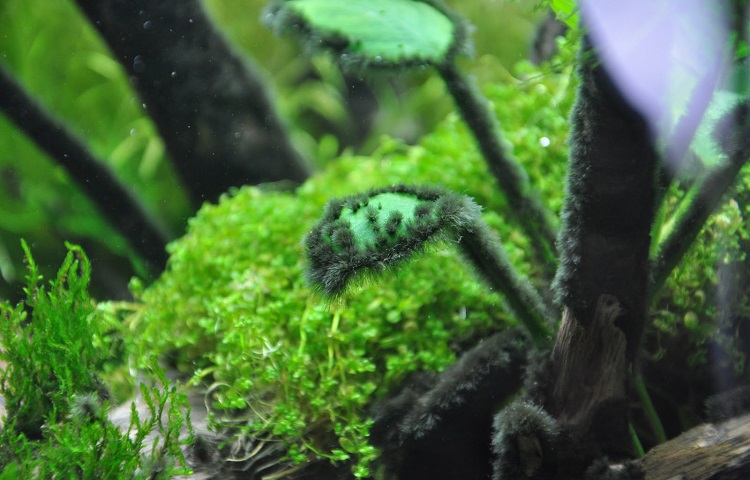
Hydrogen Peroxide is your best bet to get rid of a heavy concentration of Black bristles algae in your tank. Aquarium hobbyists can purchase this over-the-counter chemical at drugstores. In addition, nosotros highly recommend aquarium owners keep a canteen handy for solving many tank-related issues.
If your ornamentation, substrates, and plants have a layer of Blackness beard algae, consider removing them from the tank and soaking them in a Hydrogen Peroxide solution.
Ensure that you prepare the bath with 3 per centum Hydrogen Peroxide and remove the decorations and plants in three minutes. The next step is to rinse all the decorations with fresh water to remove even the slightest corporeality of Hydrogen Peroxide.
However, consider treating your entire tank with the chemic if these affected decoration pieces and plants aren't removable. Nosotros recommend using 10ml of 3 percent Hydrogen Peroxide per fifteen gallons of water.
You lot volition presently start noticing the algae'due south colour fading, and in a month, you will get rid of the entire algae trouble. You tin can also repeat this procedure twice or thrice or increment the concentration equally Black algae are pretty stubborn.
If the plants are sensitive, you can lower the ratio under 1:iii to keep them live and thriving. Since Hydrogen Peroxide leaves zero residues, you do not have to worry about scrubbing the rocks and plants.
Note: You will notice your plants changing color when they come in contact with Hydrogen Peroxide, simply the plants' color should return after some time. A minimal quantity of the chemical won't necessarily cause any harm to the fish, only one tin ever motion the fish to a new tank during the process.
Potential Issues To Consider
- Plants like Monte Carlo, Monosolenium Tenerum, Riccia, Hemianthus Glomeratus, Subwassertang, Dwarf babe tears, etc., are susceptible to impairment from chemicals similar Hydrogen Peroxide.
- Hydrogen Peroxide may kill near of the beneficial bacteria in the nitrogen cycle.
Method iii: Boosting Carbon Dioxide (CO2) Levels In Aquarium
Boosting the Carbon Dioxide levels in your aquarium can exist an effective mode to get rid of stubborn Black beard algae.
Hobbyists must note that the process won't eliminate algae spontaneously, but information technology will highly inhibit its growth, thus eventually ceasing it to exist.
This method is also splendid for aquariums that are running low on CO2. A bully sign is to see the texture of the algae. If it is stiffer than normal algae, your aquarium has lower Carbon Dioxide levels.
To heave the CO2 levels in your tank, you can either opt for Carbon Dioxide injections bachelor in the form of pressurized CO2 cylinders or employ liquid carbon like Easy Carbo, Seachem Flourish Excel, etc. We recommend aiming for approximately 20-25 ppm if the oxygen levels of your aquarium are already in a healthy range.
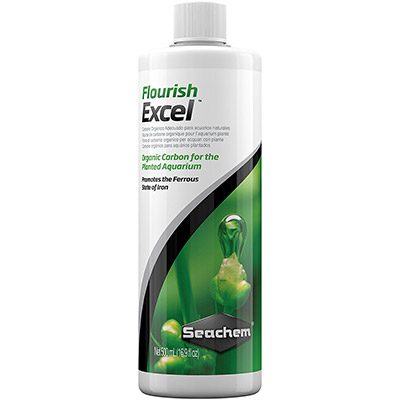
If removing blackness bristles algae is not an choice or also difficult now, this stuff is but astonishing! Non only does black beard algae hate information technology, but information technology will improve the growth of the other plants in your aquarium. This volition be especially noticeable if yous don't already inject CO2.
Using it is simple. Just follow the instructions. In my last tank, information technology took merely a few days before I began to find the black beard algae wither and die.
Ensure that your h2o menstruum is adequate to evangelize the Excel to every corner of your tank.
If you don't detect a change, double dosing may be required. Alternatively, you lot tin try spot dosing. This involves using a pipette or syringe to apply Seachem Excel direct to the algae.
Beneath is a quick video on just how effective spot treatment with Excel is!
If you take this route, inquire an expert near the corporeality of Excel you should use for each dose – the amount will vary according to the size of your tank and the number of fish that is stocked.
Black beard algae often turns a cherry/pink as information technology starts to die before finally turning a clear, white color as it dies.
This dramatic colour change is actually very helpful because information technology's obvious which areas yous need to treat next!
Potential Issues To Consider
- If yous have shrimp or sensitive fish in your tank, be careful almost this method. Pumping as well much Carbon Dioxide can result in lower Oxygen levels and a considerable pH drib, and these changes can indeed shock the aquatic life in your tank.
Method 4: Regulating Phosphate In Your Aquarium
Everyone knows that phosphate is the ultimate byproduct of almost all the edible and organic materials in your aquarium tank.
If you weren't aware of this, call back that dead plants, fish waste matter, fish food, and random organic products produce phosphates that directly encourage the Black beard algae to proliferate.
Regulating and reducing the phosphate level will starve the Black algae, making it weaker and finally eliminating it. Apart from organic materials, your tank's phosphate levels can rise with the constant use of hydrogen ion buffer solution, carbon filter media, kH buffer solutions, aquarium salts, and tap water.
Yeah, y'all heard information technology right; tap water can also incorporate high levels of PO4 that tin help the growth of Blackness algae. If you are dealing with Black algae almost constantly, consider testing your water's phosphate levels. Blackness algae tin successfully thrive in phosphate levels of 1ppm and in a higher place.
If your examination showcases digits resembling one or in a higher place, we recommend post-obit i of the post-obit suggestions:
- Choose another water source to reduce your chances of encountering Black beard algae. Generally, purified water or distilled water with reverse osmosis volition keep a check on your algae growth. Even so, ensure that you are remineralizing your h2o before using it for the water tank. Find a phosphate-free remineralizing solution like Seachem Equilibrium to re-introduce all the minerals depleted in the purification process.
- If the first pick is too wearisome, nosotros propose adding phosphate-absorbing media to your tank's filter. A canister filter volition work the all-time for such cases.
Potential Problems To Consider
- Avoid overfeeding your fish to go on the phosphate levels in bank check. Please take observe of whatsoever uneaten food and remove it before it releases phosphate.
Method five: Introduce Black Algae-Eating Fish In Your Fish Tank
This method is a purely natural mode of decision-making the robust growth of Black beard algae in your aquarium tanks.
The principle behind this method is simple- introducing algae-eating fishes in your water tank. You will exist surprised to know the varieties of fishes that consider Blackness algae their principal nutrient source.
Well, there is!
The true Siamese algae eater.
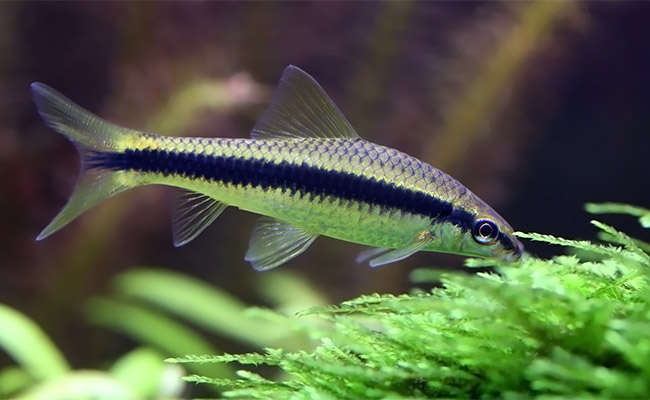
Siamese Algae Eaters, also known as SAE fishes, are famous for feasting Black algae. They tin can devour fifty-fifty the nearly robust growth of Black beard algae all past themselves.
Withal, exercise a trivial research and buy the correct species of fish. Nosotros recommend combining these fishes with CO2 injection or Hydrogen Peroxide soak for better results.
Both the methods will brand the algae weak, soft, and tender for the fish to eat. Apart from Siamese Algae Eaters, the following species can feast on Black beard algae with the aforementioned enthusiasm:
- Blackness Molly
- Bristlenose pleco
- Rubber lipped pleco
- Twig catfish
- Common Goldfish
- Rosy Barb
- Cherry Barb
- Pygmy suckermouth
- Chinese Algae Eater
You lot come across, there is no guarantee that this fish will eat the blackness bristles algae in your tank. Similar humans, fish have preferences to the type of food they eat, fifty-fifty among the same species.
And even if your Siamese algae eater does accept a sense of taste for blackness bristles algae, information technology might non exist able to crumb the algae fast enough to completely remove it from your aquarium.
This is besides a common problem with shrimp as with Siamese algae eater. While they do consume black beard algae, they cannot swallow it fast enough to make a noticeable departure.
Bank check out the video below. Despite the shrimp constantly chomping at black beard algae, they can't continue it in check.
If you want to stick to a proven method that works, and you don't want an extra mouth to feed!, I recommend using the Seachem Flourish Excel dosing method.
Potential Issues To Consider
- Many fish species mentioned in a higher place prefer eating Black algae in the absence of other food sources. And then they must be hungry with no food near their habitat to initiate eating Blackness beard algae.
- Some aquariums can be small and contested for algae-eating fish. Ensure your tank isn't overcrowded.
- These hungry fishes may showtime eating your plants inside the tank if you stop feeding them. Pay close attending to the compatibility equally y'all practice not wish to pair a few dominant fishes with a single submissive fish.
Method 6: Rut Treatment
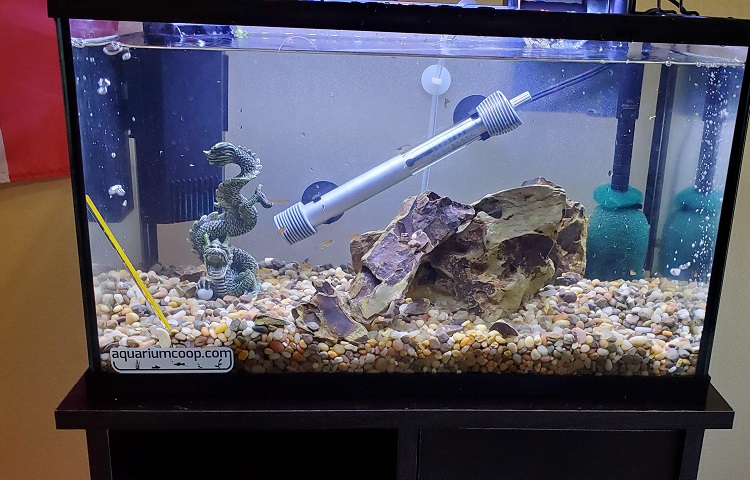
Estrus handling is a safety and harmless option if you do not want to play with potentially harmful chemicals. Algae prefer a warm environment, simply too much warmth can welt the Black algae.
Before initiating the process, you need to transfer your fish to different tanks to keep them safe. Consider placing your live plants in that other tank too. Insert a heater in your Black algae-riddled tank effectually 110°F to 120°F for an hour.
If your live plants have a layer of Black algae, place them in a Hydrogen Peroxide mixture in the meantime. The estrus in the tank will slowly and effectively burn the Blackness algae causing it to die without using whatsoever harsh chemicals in the process.
Potential Bug To Consider
- Remember that this method isn't suitable for live plants or plastic ornamentation. Alive plants will surely burn while the plastic decor volition cook within minutes.
- If you lot opt to boil your Blackness algae-infested pebbles and rocks, ensure to use a pot with a tight-fitting lid. Well-nigh porous rocks may pose a threat of explosion when exposed to intense estrus.
Method 7: Cutting The Photosynthesis Of The Black Algae
We exercise not recommend this approach if your tank has multiple plants. However, if your tank has no plants or a unmarried removable live plant, go alee with this method.
This cure won't eliminate your Black algae infestation instantly, only yous tin can surely get rid of the growth over time. Consider switching off the artificial lights of your tank for 4 days.
If y'all have your fish tank well-nigh sunlight, take it inside or wrap it with a black cloth. After the get-go four days, reduce the daily light dose by half. You will shortly notice a steady pass up in the growth of Black beard algae.
Potential Issues To Consider
- Plants that require a lot of sunlight won't thrive in such conditions.
Conclusion
All aquarium enthusiasts tin can agree that these Blackness bristles algae are the most stubborn algae variety.
While information technology may non be harmful to fish, unwanted blackness beard algae can before long embrace every corner of your tank – and to many, information technology looks darn ugly.
Notwithstanding, past maintaining proper tank parameters, and careful attempts on removing blackness bristles algae, you should be able to prevent black bristles algae from actualization in the kickoff place.
How did you go rid of black beard algae in your aquarium? Let me know in the comments below!
Source: https://fishlab.com/black-beard-algae/
0 Response to "How to Make Fake Fury Stringy Again"
Post a Comment